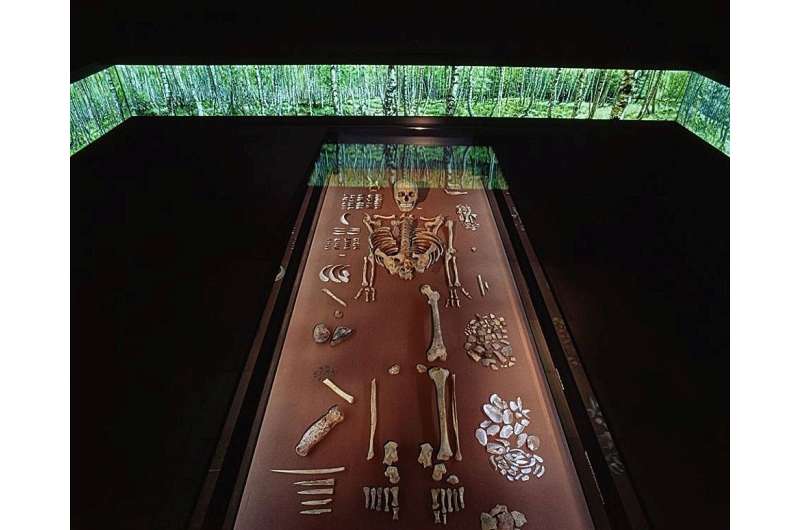This article has been reviewed according to Science X's editorial process and policies. Editors have highlighted the following attributes while ensuring the content's credibility:
fact-checked
proofread
Genetic research into a 9,000-year-old shaman burial in Germany

The double burial of an adult woman and an infant, dating to about 7000–6800 BCE, discovered in 1934 during construction works at the spa gardens of Bad Dürrenberg, is regarded as one of the outstanding burial finds of the Mesolithic in Central Europe. Because of the unusual equipment with the woman, who was buried in a seated position, and her bodily anomalies, the burial is interpreted as that of a shaman.
Genetic research now reveals the relation of the woman and the child: the boy is not her son, but is a fourth- or fifth-degree relation. The phenotypic variants analyzed in the woman's genome inform us that she had a relatively dark skin complexion, dark, straight hair, and blue eyes.
The burial
The unusual equipment buried with the woman comprises flint artifacts and solid rock tools, but also bone and antler artifacts, a piece of red ochre, a number of animal bones including the shell of at least three terrapins and partly pierced animal teeth. Together with deer antlers and originally six partly pierced boar's tusks, these finds are probably head/body ornaments. Due to the grave goods and bodily anomalies of the woman, the burial is interpreted as that of a shaman.
Subsequent excavations at the site as part of the preparations for the State Garden Exhibition 2024 brought not only new revelations about the deposition and positioning of the body to light, but also revealed a multitude of new finds, which could be clearly attributed to the burial. Besides the pierced animal teeth, remains of fauna, lithic artifacts and a large amount of human skeletal remains could also be recovered.
A recent article, published as a chapter in the conference proceedings Propylaeum, by Jörg Orschiedt (State Office for Heritage Management and Archaeology Saxony-Anhalt, LDA), Wolfgang Haak (Max-Planck-Institute for Evolutionary Anthropology), Holger Dietl (LDA), Andreas Siegl (LDA), and Harald Meller (LDA) details the results of recent work on the find, which included a DNA-analysis.
The shaman
The study finds that the 30- to 40-year-old woman was a gracile person with a body height of about 1.55 m, typical for the period. Notably, her skeleton lacked distinct muscle attachments, especially on the lower extremities, which are commonly found in hunter–gatherers.
At the base of the skull, there is an anomaly at the edge of the great occipital hole, in the form of a small constriction. This area is the imprint of an abnormally developed blood vessel. The first cervical vertebra is incompletely formed due to a congenital growth defect and has only reached 40% of the arch. The rounded end of the vertebral arch corresponds to the previously observed defect at the large occipital hole.
In this context, the researchers hypothesized that a pinching of the blood vessel with various sequelae appears possible with a corresponding head posture. The discovery of the second cervical vertebra among the finds of the re-excavation confirmed this. This vertebra also shows an anomaly, which is limited to the vertebral process in the form of a protruding bone clasp. This makes a blockage of one of the blood vessels leading to the brain plausible.
This can be caused intentionally by adopting a certain head posture. The consequences are unlikely to have been serious or hazardous to the person's health. However, it is conceivable that a nystagmus, i.e., an involuntary movement of the eyeballs, could be caused by the blockage of a blood vessel. This unusual feature might have been perceived as uncanny and when initiated on purpose may have reinforced or even justified her role as a shaman.
Genetic research revealed that the genomic ancestry profile of the shaman falls squarely within several dozen other Mesolithic hunter-gatherer individuals from central and western Europe, a profile which is commonly called Western (European) hunter–gatherer ancestry.
The phenotypic variants analyzed in the Bad Dürrenberg genome reveal that the shaman had a relatively dark skin complexion, dark, straight hair and blue eyes. This combination was quite common among hunter–gatherer individuals from Western Europe and the shaman lady shared this appearance with contemporaneous Mesolithic individuals from sites such as Loschbour, Mullerthal (Luxembourg), La Braña, Asturias (Spain), or Cheddar Man in Somerset (Britain).
The child
During re-excavations of the Bad Dürrenberg site, the partially preserved skeleton of an infant was discovered. The discovery of the petrosal enabled a genetic analysis of this individual. Since high-quality data from both individuals, and especially from the female, was available, researchers could also employ a newly developed method to scan the genome data for the presence, amount and length of tracts in the genome that are shared by two individuals, so-called identity-by-descent (IBD) tracts. This method, optimized to deal with missing data, as is common in fragmented ancient DNA, allows the detection of biological higher degree relatedness, and with reservations, up to the 10th degree.
Concerning the two Bad Dürrenberg individuals, the researchers found that the number and length distribution of identify-by-descent tracts that are shared between the pair is equivalent to genetic relatedness of the fourth or fifth degree. This degree of relatedness could be equivalent to four or five generations apart, assuming a direct line, which would make the adult female the potential great-great-(great)-grandmother of the boy.
More information: Jörg Orschiedt et al, The Shaman and the Infant: The Mesolithic Double Burial from Bad Dürrenberg, Germany, Propylaeum (2023). DOI: 10.11588/propylaeum.1280.c18002
Provided by Landesmuseum für Vorgeschichte



















